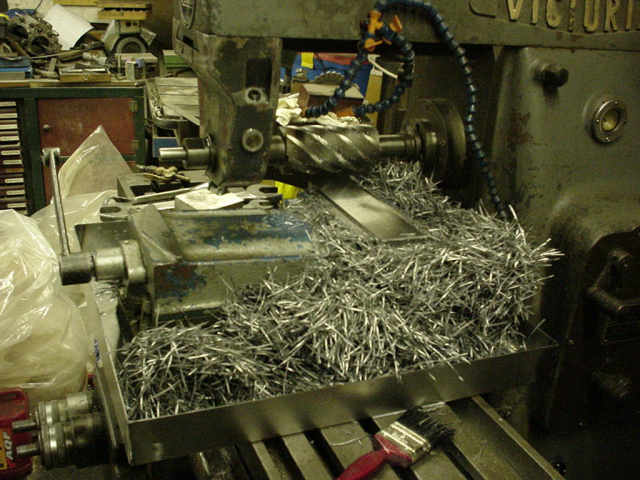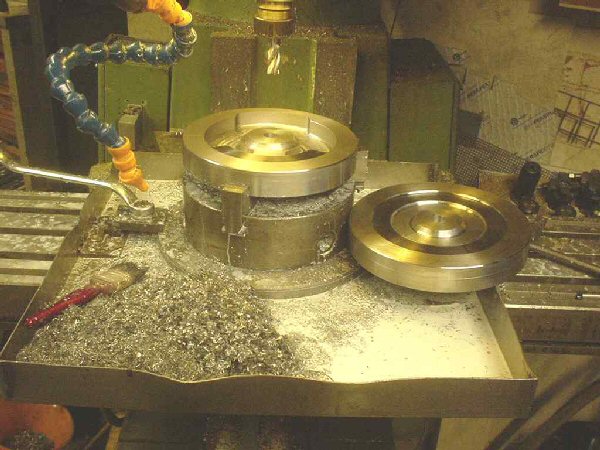The third major part of my shop upgrade arrived at lunchtime today.
Luckily, my friend Tel was here visiting, and without him my new lathe wouldn't have made it. The delivery came on a curtainsider, and it must have been loaded by forklift from the side. The pallet was too long to be handled with the pallet truck the driver had, in the position it was sited on the wagon, so Tel took over and and had it off in ten minutes, the driver didn't have a clue. It was also listed as only weighing 200kilos, in fact it is 450kilos. Someone has been cooking the books.
So anyway, after having signed for it as 'unchecked because of packaging' (covers me if anything is found damaged as it is unpacked). The first two bits came in stout cardboard boxes weighing about 30 kilos each (about 65lbs). These boxes contained the main lathe stand, no pressed steel here, welded up out of 1/4" plate, with a plate on the top that must be at least 1/2" thick, with the top faces machined level. The left hand one is the storage cupboard and access to the emergency stop foot operating pedal linkage. The one on the right is actually showing the rear face, and this contains a very solid suds pump and tank.
Whenever you receive something like this, if possible cover yourself by taking photos of any damaged areas on the outside of the box, and at each stage of unpacking. Just in case there is damage, so you can prove that it was done prior to the final unpacking stage.
So the top was removed first. It came off fairly easily, so the box had been opened before.
Protective packing peeled back and the first look at the new bit of equipment. It was given a full dose of looking at without touching anything, no damage as far as I could see. The whole machine is covered in a protective gunk that will eventually be removed.
In the bottom of the box was a very comprehensive toolkit, in a nice plastic toolbox, of the same type as came with the mill. Lots of bubble wrapped bags in there as well, all the bolts and fittings like DRO head, plus a load of extras I had ordered. Each bag was checked against the inventory and all was found OK, except I had ordered 20 standard tool holders and only 8 in there. On checking paperwork, the have back ordered another 12 for me.
Once the loose bits were checked, time to check all the bits that were advertised to come with the lathe.
Under the lathe, bolted to the crate was a 10" face plate, again, fixed to the bottom of the box, in bottom right hand corner was an 8" four jaw independent. QCTP was in position already, as was suds pump pipework and DRO read heads.
I also noticed that only one chuck key was supplied, but on checking it out, it fit both supplied chucks and the camlock chuck locking, so it looks like someone has been doing their homework.
The other half shows travelling and fixed steadies plus 6" 3 jaw, halogen lamp (including expensive bulb) and micrometer saddle stop (looks like a few mods needed on that, I like at least 3 stops).
Also note below the chuck on the bed, this has what is called a gap bed, where a section can be removed to allow much larger parts to be swung if needed. Not a thing to leave out permanently, as the lathe can easily twist out of shape, but OK if done occasionally for that 'special' job.
So it looks like no damage as yet, and all bits are present.
Time to unpack a bit further.
No sooner had I taken the front off, the nose on legs was in there, checking for nasties.
I was there soon after checking for damage. None at all found. So no phone calls yet to the supplier.
Now this is one of the main reasons I went for this special model. Almost everything I need is on this front panel. The two top levers with arrows give me 18 speeds, the other one gives me leadscrew fwds/rev. I also have motor fwds/rev controlled by a handle on the bottom of the three shafts. The middle one is for cross feed and the top is the standard leadscrew.
The four knobs on the bottom control the speeds to both the top shafts for screwcutting and feed.
A full set of charts are provided on the front for speeds and feeds plus metric and imperial screwcutting. A set of change gears are supplied to change the machine between the two.
One thing I don't seem to be able to adjust to is the squareness of everything. I have always used machines that have voluptuous curves and rounded corners. I will have to see if I can get used to this minimalist approach to machinery.
Another point I liked about this machine is the fact it has dual met/imp resettable scales on all controls, including the tailstock. So really it can be used as a machine for both standards, even without using the DRO.
I have never been able to get close to one of these machines before now, as they never had any in stock, and I had to pre order this one three months ago. And they still have a backlog of orders.
I think the reason is, and Chester UK admit to this. The machine is grossly over specced for the price. They reckon it should be £500 dearer, and I would agree with that. In fact I got this at a much lower price than is shown on their website. Cash talks.
A had a good look thru the test report that came with the machine and found them very encouraging, from the tailstock being only 0.0015" higher than the spindle, to the 0.001" runout at the end of a 1ft long test bar sticking out of the spindle. To me, well within acceptable tolerances. But only time and tweaking will tell.
So now it is boxed up again. My mate Tel refused to get it on his back, and carry it into my shop, so I have now to wait until my machine moving man comes to do it for me. Hopefully sometime next week.
John

























































































